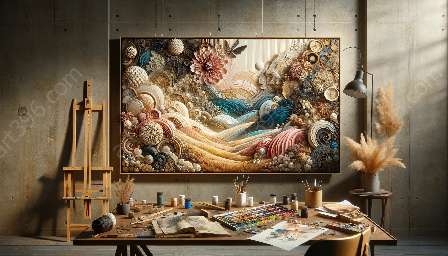Mixed media art encompasses a wide range of techniques and materials, allowing artists to create multidimensional artworks that combine various elements in innovative ways. The principles and elements of mixed media art play a vital role in shaping the visual appeal and expressive impact of these artworks. This topic cluster explores the foundational principles and elements of mixed media art and their relevance to visual art and design.
Understanding Mixed Media Art
Mixed media art refers to artworks that integrate different materials, such as paper, fabric, wood, metal, found objects, and more, with traditional artistic mediums like paint, ink, and collage elements. This versatile form of art allows artists to experiment with textures, layers, and visual elements, resulting in dynamic and compelling compositions.
Principles of Mixed Media Art
The principles of mixed media art guide artists in creating cohesive and visually engaging artworks. These principles include:
- Layering: Building layers of different materials and mediums to create depth and complexity within the artwork. Layering adds visual interest and can convey a sense of narrative or history within the piece.
- Texture: Exploring tactile elements and surfaces, such as rough textures, smooth finishes, or raised relief, to enhance the sensory experience of the artwork.
- Collage: Incorporating found objects, photographs, magazine clippings, and other materials to juxtapose disparate elements and create unexpected visual connections.
- Integration: Blending diverse materials and techniques seamlessly to achieve a harmonious and unified composition, where each element contributes to the overall aesthetic impact.
Elements of Mixed Media Art
The elements of mixed media art encompass the fundamental visual components that artists manipulate to convey their artistic vision. These elements include:
- Color: Utilizing a diverse color palette, artists can evoke moods, convey symbolism, and create visual harmony or contrast within their mixed media artworks.
- Shape and Form: Experimenting with various shapes, from geometric to organic, and exploring three-dimensional forms to add depth and visual interest to the artwork.
- Texture: Manipulating tactile textures through the use of different materials and techniques, such as impasto, collage, or assemblage, to engage the viewer's senses and enrich the overall composition.
- Composition: Arranging visual elements, such as focal points, balance, rhythm, and proportion, to create a unified and effective composition that guides the viewer's gaze.
Mixed Media Art in Visual Art and Design
The principles and elements of mixed media art are integral to the broader context of visual art and design. Within the realm of visual art, mixed media techniques provide artists with the freedom to explore and push the boundaries of traditional artistic practices, resulting in innovative and thought-provoking creations.
Furthermore, in the field of design, the principles and elements of mixed media art inspire designers to incorporate multidisciplinary approaches, experiment with new materials and processes, and engage with diverse visual languages to convey impactful messages and create immersive experiences.
Conclusion
Mixed media art embodies a dynamic and expressive form of artistic creation, where the principles and elements serve as guiding principles for artists to push the boundaries of creativity and visual storytelling. Whether in the realm of visual art or design, the versatile and adaptable nature of mixed media art continues to inspire new generations of artists and designers, offering endless possibilities for creative exploration.

